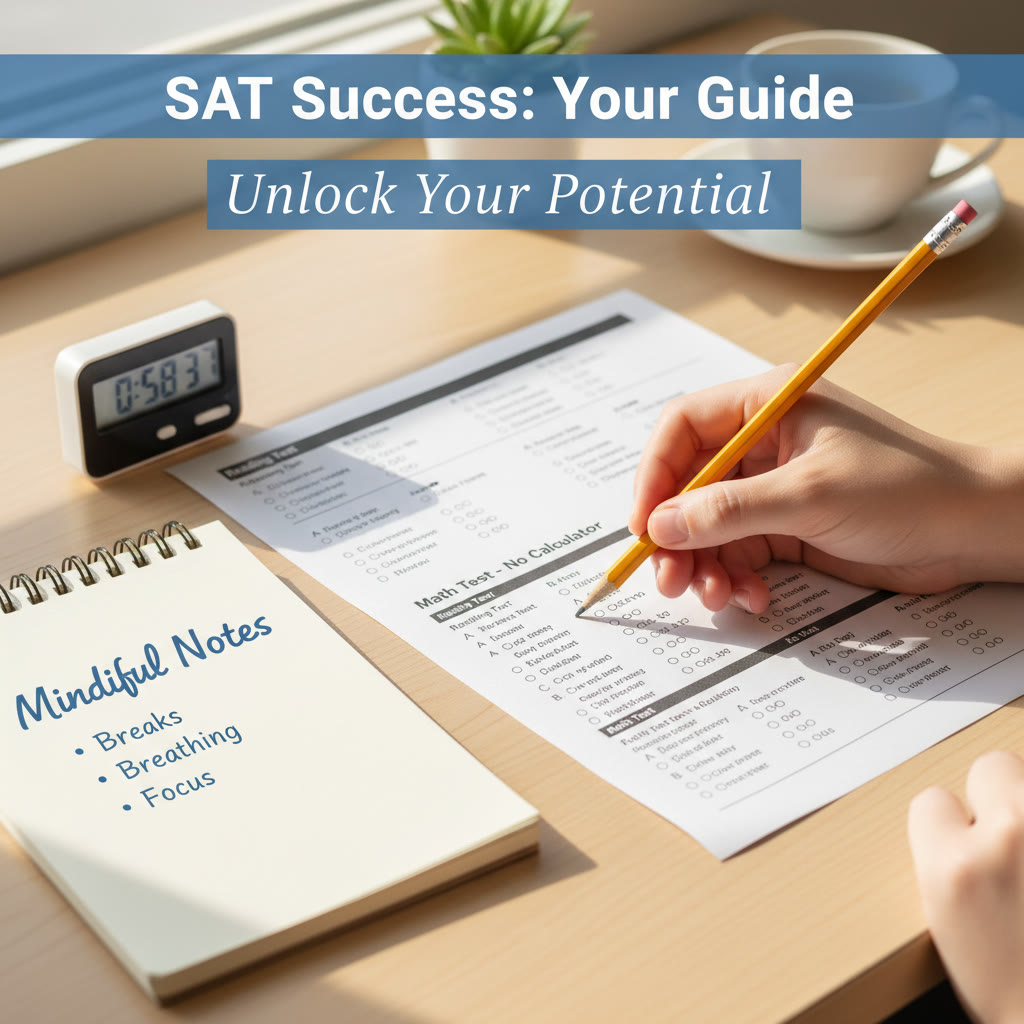Why Mindfulness Matters for SAT Preparation
When you picture SAT prep, you might imagine highlighters, practice tests, flashcards, and long stretches of focused work. What often gets left out of the image is the inner landscape of the student doing the work: thoughts racing, heart pounding before a practice test, or the stubborn anxiety that shows up five minutes before you begin a math section. Mindfulness is a simple, practical tool that calms that inner noise, sharpens attention, and helps the hours you spend studying translate into actual performance on test day.
Mindfulness doesn’t require incense, long retreats, or mystical language. At its core it means paying attention on purpose, moment by moment, without judgment. For SAT students that translates into noticing when focus drifts, gently bringing attention back to the problem at hand, and using simple techniques to reset when stress creeps in. Research across attention and stress studies shows that short, regular mindfulness practice improves working memory, reduces test anxiety, and enhances cognitive control—exactly the skills you need on test day.
How Mindfulness Helps Different Parts of SAT Prep
Not every study session looks the same. Mindfulness supports the different tasks involved in SAT prep in distinct ways:
- Reading passages: Mindful attention helps you slow down, notice the author’s tone, and avoid skimming so quickly you miss key details.
- Writing and language: Awareness of habitual mistakes makes it easier to spot sentence-level errors and to read choices more carefully.
- Math sections: Mindfulness reduces impulsive answering and encourages methodical work—important for multistep problems.
- Full-length practice tests: Short mindfulness breaks help reset attention between sections, curbing fatigue and preserving accuracy late in the test.
Quick Mindfulness Practices You Can Use Right Now
When you need a fast reset during a study session or before a practice test, use these short, practical exercises. They take between 30 seconds and five minutes and can be done anywhere.
1. The Three-Breath Reset (30–60 seconds)
Why it works: It anchors attention to the breath, slowing heart rate and shifting you out of reactive mode.
- Sit comfortably. Close your eyes if that feels okay.
- Inhale slowly for a count of four, feel the breath expand the chest and belly.
- Exhale for a count of four. Repeat three times.
- When your mind wanders, gently return to the breath—no judgment.
2. Grounding 5-4-3-2-1 Exercise (1–2 minutes)
Why it works: It’s a quick sensory check that pulls you into the present moment and away from anxious thoughts about outcomes.
- Name 5 things you can see right now.
- Name 4 things you can feel (texture of the desk, your feet on the floor).
- Name 3 things you can hear.
- Name 2 things you can smell or like the smell of.
- Name 1 thing you appreciate about this study session.
3. Focused Body Scan (3–5 minutes)
Why it works: It removes tension, helps you notice subtle fatigue, and tells you whether to keep pushing or take a real break.
- Sit or lie down comfortably. Close your eyes if you like.
- Direct attention to your feet, then gradually move up through your legs, hips, torso, arms, neck, and face.
- At each area, notice tension or relaxation. Breathe into tight places and let them soften on the exhale.
Building Mindful Habits Into Your SAT Study Plan
Integrating mindfulness into your study schedule is more effective than trying to cram a single long meditation session into a busy week. Small, consistent practices compound. Below is a sample weekly structure that blends focused study blocks with mindful resets.
| Day | Study Blocks | Mindfulness Practice | Goal |
|---|---|---|---|
| Monday | 2 x 45-minute focused sessions | 3-minute body scan between sessions | Deep practice on algebraic problem types |
| Tuesday | 1 x 90-minute reading practice | Three-breath reset before each passage | Improve passage mapping and evidence citation |
| Wednesday | 2 x 45-minute mixed practice | 5-minute grounding mid-session | Build speed and accuracy |
| Thursday | 1 x 60-minute timed section | Short visualization of calmly completing the section | Practice pacing under time pressure |
| Friday | 2 x 40-minute targeted drills | Mindful stretching between drills | Strengthen weakest areas |
| Saturday | Full-length practice test | One-minute breath resets between sections | Simulate test-day conditions |
| Sunday | Review and light practice | 30-minute longer meditation or nature walk | Consolidate learning and rest |
This schedule is a template. If you work with a tutor you can tailor it to your learning needs—Sparkl’s personalized tutoring, for example, combines 1-on-1 guidance and tailored study plans to help you decide where to place mindfulness practices for the biggest payoffs. Tutors can help you track which mindfulness techniques improve your concentration or reduce careless errors, and Sparkl’s AI-driven insights can highlight trends in your practice so you keep what works and adjust what doesn’t.
Mindful Techniques for Specific SAT Sections
Different sections benefit from slightly different mindful approaches. Here are focused strategies for each core area of the SAT.
Critical Reading and Evidence-Based Reading
- Before you begin a passage, take the three-breath reset. This reduces impulsive skimming and helps you read with intention.
- Practice “one-sentence summary” after each paragraph. Pause, and in one mindful sentence state the main idea—this builds comprehension and memory.
- Use a gentle finger or pencil to guide your eyes. The physical movement keeps attention anchored to the text.
Writing and Language
- Notice common mental habits that cause errors, like rushing or assuming sentence structure. When you catch the habit, gently label it “rushing” and return to a calm pace.
- Read both the sentence and the surrounding context slowly. Use a short pause to imagine saying the sentence out loud; sometimes hearing the rhythm exposes mistakes.
Math
- When a problem feels frustrating, stop and do a 60-second grounding exercise. Frustration narrows attention and fosters careless errors.
- Practice checking your work mindfully: after solving, take a breath and read each step like a story. Are units consistent? Does the result make sense?
- Use visualization as part of your approach: picture the equation balancing or the graph shifting as you manipulate variables.
Managing Test Anxiety With Mindfulness
Anxiety can show up as blanking on facts, rushing through questions, or physical symptoms like sweaty palms and racing thoughts. Mindfulness doesn’t promise to erase anxiety overnight, but it changes your relationship to it. Instead of panic becoming the center of your experience, anxiety becomes one part of the field you can observe and respond to intentionally.
Labeling and Letting Go
A simple technique is to label the emotion when it appears: “Anxiety,” “Tightness,” “Worry.” Naming reduces the intensity of the experience. Practice this during study sessions so the habit carries over to the exam: when a negative thought arrives, mentally say “thinking” or “anxious” and then return to the task at hand.
Creating a Pre-Test Ritual
Rituals anchor you. A consistent 3–5 minute pre-test routine that includes focused breathing, a brief body scan, and a positive affirmation can quiet the mind and set a predictable baseline. For instance:
- Three slow breaths, counting to four on inhales and exhales.
- Scan shoulders and jaw, relax tension.
- Mentally say a short cue like “I will focus on one question at a time.”
Put that ritual into simulated test conditions during practice tests so it becomes automatic on the real day.
Mindful Study Techniques That Improve Retention
Mindfulness supports better learning, not just calmer study. Here are study techniques infused with mindful principles to improve memory and recall.
Interleaved Practice With Mindful Reflection
Interleaving means mixing different types of problems in a single session instead of repeating the same kind of problem over and over. After each block, take 60–90 seconds to mindfully reflect: what strategy did I use? What tripped me up? This brief reflective pause strengthens the learning loop and helps embed flexible problem solving.
Active Recall and Mindful Self-Testing
When you practice active recall—closing the book and trying to reconstruct a solution—you create a small moment of discomfort. Use mindfulness to notice the feeling of not knowing and stay with it calmly. Over time, tolerance for that uncertainty grows, and recall improves.
Sample Scripts: What to Say to Yourself
Words matter. How you speak to yourself in the middle of a practice test changes outcomes. Try these neutral, grounding scripts when you notice stress or distraction:
- “I can do one problem well right now.”
- “Breathe in. Breathe out. Read the question slowly.”
- “This is just a practice moment. Try once more with calm focus.”
Pair these scripts with a three-breath reset, and they become a compact tool kit for anxious moments.
Using Technology Mindfully
Phones, timers, and apps can be both a help and a hindrance. Use technology to support mindful study rather than fragment it:
- Set a simple timer for focused blocks (e.g., 25 or 45 minutes), then take a planned mindfulness break.
- Use apps that play neutral ambient sounds for deep focus if silence leads to anxiety—just avoid social media or distracting notifications.
- If you work with a tutor, incorporate data from study platforms into mindful reflection. Sparkl’s tutoring model uses expert tutors and AI-driven insights to highlight where your attention slips and to personalize study plans—turning those analytics into mindful checkpoints rather than sources of stress.
Measuring Progress Without Getting Stressed
Progress in SAT prep isn’t just a number. It’s about steady improvement in attention, fewer careless errors, and the ability to maintain calm under time pressure. Here are mindful ways to track progress:
- Track patterns, not single scores: notice if careless errors decrease after adding a grounding break between sections.
- Keep a brief journal: after each practice test, write one sentence about what felt different in your attention or mood.
- Set process goals (number of mindful resets, minutes meditated per week) in addition to outcome goals (score targets). Process goals are under your control and reduce the anxiety tied to outcomes.
When to Seek Personalized Support
If anxiety feels overwhelming or your attention consistently derails despite your best efforts, personalized support can accelerate progress. Working 1-on-1 with a tutor lets you blend targeted content help with habit coaching. Sparkl’s personalized tutoring offers tailored study plans and expert tutors who can design mindfulness-ready study routines that fit your personality and learning style, and use AI-driven insights to adjust plans as you improve.
Personalized help is especially useful when:
- You notice the same error patterns repeat under stress.
- Your practice test scores fluctuate widely week to week.
- You want a structured way to combine skill-building, test strategies, and mindfulness practices into a single plan.
Putting It All Together: A Day of Mindful SAT Practice
Here is an example day that demonstrates how to weave mindfulness and focused study into your routine without adding complexity.
- Morning: 15 minutes of light review (vocab or math formulas). Start with a three-breath reset and a short intention: “I will focus for 25 minutes.”
- Midday: Two focused 45-minute sessions using interleaved practice. Between sessions, do a 3-minute body scan and drink water.
- Afternoon: Timed reading section. Before each passage, do the three-breath reset and write a one-sentence summary after each paragraph.
- Evening: 20 minutes of review and a 10-minute mindful walk or meditation to consolidate learning and release stress.
Final Thoughts: Small Changes, Big Results
Mindfulness is not a magic pill, but it is deceptively powerful. The small practices—three deep breaths, a quick body scan, a short reflection after a problem—combine to make your study hours more efficient and your test-taking more resilient. These habits change not only how you study, but how you show up on test day: calmer, clearer, and more focused.
If you want help tailoring these techniques to your schedule or learning needs, consider combining mindfulness with personalized tutoring. Sparkl’s tutors and AI-driven insights can help you place mindfulness where it will have the most impact and create a study plan that balances skill work and mental fitness. The goal is a sustainable routine you can carry into test day and beyond.
Remember: consistency beats intensity. Ten mindful, focused minutes every day will do more for your SAT performance than one frantic marathon of study. Start small, notice the difference, and build from there—one breath at a time.
















No Comments
Leave a comment Cancel